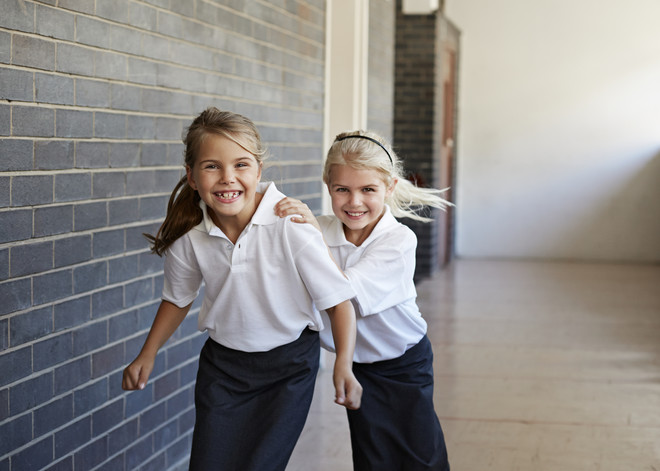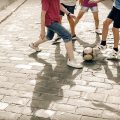one. Preparing for teachingWhy why many parents think that readiness for school is determined by the ability to read, count, write. In fact, teachers usually even ask particularly active mothers NOT to teach a child to read and count to school, because the school has its own teaching method. But to prepare a child for learning is important. So that the hand is ready to learn how to write letters, you can work with the child on developmental aids - draw straight lines, draw shapes, paint, stick within the outline, and so on. You can prepare for mathematics by developing logic, and not by solving complex examples. Physiologists recommend the future first-grader to more often engage in coloring coloring and unraveling mazes, trying not to drive on paper with a finger, but following the path with his eyes. And it is also important to be able to generalize (separate all the vegetables from all animals, or select only the objects in the picture with the letter “A”). Photo: Getty Images2. Teach to live, not read. Not only numbers and letters are waiting for a child’s school. The most important thing is communication with dozens of new people, both children and adults. Discuss what the child will do to make friends with classmates (smile, share candies, discuss their abilities ...), and how she will address the teacher (“you” and by name and patronymic). Explain also that the teacher is not Mama. She will not hug and feed, she will teach, this is her job. And she treats all children in the class equally. It is important to teach the child with any difficulty and feeling unwell not to be shy about approaching the teacher. Check whether the child can dress himself, change the clothes, does it with laces on sneakers, zippers and zippers on the uniform and briefcase. Remember that in school the child will cope independently, do not complicate his life by buying difficult-to-close briefcase and pencil case. Practice your child asking for leave from the lesson in the toilet with the words "you can go out" without details After all, it is so accepted among the students. To acquaint with the teacher Well, if you manage to do this in advance, before September 1. Then the child will go to school without fear of the unknown. Teachers start working from the middle or from the end of August, try to go to school, watch the class, walk along the corridors, talk to the teacher.4. Stop all control You, of course, want to spread straws, protect your child, walk to the class, do all the lessons for a first grader, tie his shoelaces to him in the morning and shout after him: “Do not forget to eat!” But it's time to stop. The child grows, he has appeared HIS business. Let him be independent. Help only when he himself just can not cope. And do not disgrace in front of classmates, tying shoelaces.
Photo: Getty Images2. Teach to live, not read. Not only numbers and letters are waiting for a child’s school. The most important thing is communication with dozens of new people, both children and adults. Discuss what the child will do to make friends with classmates (smile, share candies, discuss their abilities ...), and how she will address the teacher (“you” and by name and patronymic). Explain also that the teacher is not Mama. She will not hug and feed, she will teach, this is her job. And she treats all children in the class equally. It is important to teach the child with any difficulty and feeling unwell not to be shy about approaching the teacher. Check whether the child can dress himself, change the clothes, does it with laces on sneakers, zippers and zippers on the uniform and briefcase. Remember that in school the child will cope independently, do not complicate his life by buying difficult-to-close briefcase and pencil case. Practice your child asking for leave from the lesson in the toilet with the words "you can go out" without details After all, it is so accepted among the students. To acquaint with the teacher Well, if you manage to do this in advance, before September 1. Then the child will go to school without fear of the unknown. Teachers start working from the middle or from the end of August, try to go to school, watch the class, walk along the corridors, talk to the teacher.4. Stop all control You, of course, want to spread straws, protect your child, walk to the class, do all the lessons for a first grader, tie his shoelaces to him in the morning and shout after him: “Do not forget to eat!” But it's time to stop. The child grows, he has appeared HIS business. Let him be independent. Help only when he himself just can not cope. And do not disgrace in front of classmates, tying shoelaces. Photo: Getty Images5.Teach how to resolve conflictsAt school, your child will have his first "colleagues." These are not friends in kindergarten with whom you can eat sand and fight over a shovel. Here, everyone is already grown up, and everyone has their own character, and everyone thinks that they are the best here... Conflicts are inevitable. But do not rush to school at the first complaint from your child that he was offended, shouting: "I'll show them how to offend my baby!" Baby needs to learn not to avoid conflict, but to resolve it. Discuss, help with advice, say that you understand, and it happened to you too, but do not decide issues for the child. 6. Let the child choose a school bag and pencil caseA school bag and pencil case (well, and notebooks and other little things) are what the child should like. Buy these things together. You will look at practicality and convenience, and the child will choose "his" school bag. After all, he will be walking with it. 7. Don't send your child to sections right awayIn the first year at school, the stress on a child is unimaginable. It seems to us that he is doing some stupid things there - sticks and hooks... But for a first-grader, the need to sit for several lessons in a row, be silent, concentrate, work in a large group is hard work. Therefore, psychologists and teachers ask parents not to burden their child with sections and classes in the first grade. It is better to take an extra walk after school and before bed, it is better to play at home than to spend all your free time in art and music schools. One exception - sports sections are always welcome. After all, sports help change activities and give strength. 8. Don't scare with schoolThere are such cheerful parents who remember in front of their child how their teacher hit them with a ruler, how they ran away from lessons, how classmates threw away their school bags and what a terrible school was... Remember that your child perceives every word as the truth. Mom and Dad didn't like school - that means school is bad and I don't want to go there. It is better to tell positive stories from your school life. 9. Teach them that books are friends A child who loves books will be more successful at school than one who is used to tablets and TV. A child who knows that books are interesting will study with pleasure. Let your child have his own low shelf with books in his room, read aloud to the first-grader (and do not stop just because he already knows the letters himself), buy coloring books and educational games with different interesting tasks, try to prepare reports for school on encyclopedias with pictures. And always discuss what you have read. This way, the child will understand that books are knowledge, entertainment, emotions and development. 10. Buy a uniform made of natural fabrics School uniforms are different for everyone. And, as a rule, in order for it to last longer, it is sewn from practical fabric, in which synthetics are at least 30-40%. Practical - that's true. But it is hard for a small child to sit all day in synthetics, to run around during breaks in a hot acrylic jacket. If there are no uniform options, at least choose cotton T-shirts, shirts, tights and vests-jackets.
Photo: Getty Images5.Teach how to resolve conflictsAt school, your child will have his first "colleagues." These are not friends in kindergarten with whom you can eat sand and fight over a shovel. Here, everyone is already grown up, and everyone has their own character, and everyone thinks that they are the best here... Conflicts are inevitable. But do not rush to school at the first complaint from your child that he was offended, shouting: "I'll show them how to offend my baby!" Baby needs to learn not to avoid conflict, but to resolve it. Discuss, help with advice, say that you understand, and it happened to you too, but do not decide issues for the child. 6. Let the child choose a school bag and pencil caseA school bag and pencil case (well, and notebooks and other little things) are what the child should like. Buy these things together. You will look at practicality and convenience, and the child will choose "his" school bag. After all, he will be walking with it. 7. Don't send your child to sections right awayIn the first year at school, the stress on a child is unimaginable. It seems to us that he is doing some stupid things there - sticks and hooks... But for a first-grader, the need to sit for several lessons in a row, be silent, concentrate, work in a large group is hard work. Therefore, psychologists and teachers ask parents not to burden their child with sections and classes in the first grade. It is better to take an extra walk after school and before bed, it is better to play at home than to spend all your free time in art and music schools. One exception - sports sections are always welcome. After all, sports help change activities and give strength. 8. Don't scare with schoolThere are such cheerful parents who remember in front of their child how their teacher hit them with a ruler, how they ran away from lessons, how classmates threw away their school bags and what a terrible school was... Remember that your child perceives every word as the truth. Mom and Dad didn't like school - that means school is bad and I don't want to go there. It is better to tell positive stories from your school life. 9. Teach them that books are friends A child who loves books will be more successful at school than one who is used to tablets and TV. A child who knows that books are interesting will study with pleasure. Let your child have his own low shelf with books in his room, read aloud to the first-grader (and do not stop just because he already knows the letters himself), buy coloring books and educational games with different interesting tasks, try to prepare reports for school on encyclopedias with pictures. And always discuss what you have read. This way, the child will understand that books are knowledge, entertainment, emotions and development. 10. Buy a uniform made of natural fabrics School uniforms are different for everyone. And, as a rule, in order for it to last longer, it is sewn from practical fabric, in which synthetics are at least 30-40%. Practical - that's true. But it is hard for a small child to sit all day in synthetics, to run around during breaks in a hot acrylic jacket. If there are no uniform options, at least choose cotton T-shirts, shirts, tights and vests-jackets.

Making Money with Desserts: Success Stories
Evgeniya Polischuk (Fedutinova) instagram:@evgeniyafedutinovavk.com/janeshomebaking– It all started with baking for family and friends. Gradually, I started posting photos of my baked goods on Instagram – and orders started coming in. I made my first custom-made cake on October 13, 2014, and a little earlier I started making macaroons and cupcakes. You could say that the business “found me”, I am very […]

Soups are cold recipes with photos
Cold cucumber soup with yogurt and lemonsorbet from the chef of the restaurant La Taverna Alexander Zhurkin Photo: Getty Images Ingredients: Plain yoghurt – 125 g Cucumber – 150 g Lemon/lime sorbet – 50 g Cocktail shrimp – 24 g Fresh ginger juice – 1 g Lime juice – 5 g Fresh orange juice – 5 g Parsley – 1 g Pink pepper – 1 g Watercress – […]

barbeque kebab
Pork tenderloin in glaze Photo:Dmitry Bayrak/dbstudioPreparation time: 20 minutes + marinating time.Calories: 454 kcal per serving.For 4 servings: 4 pork tenderloins (approximately 300 g each), 1 onion, 2 cloves of garlic, 1 tsp. lemon zest, 1 tsp. lemon juice, a pinch of ground cumin, coriander and turmeric, 1 tbsp. vegetable […]

Pierre Duacan: dietary recipes: Ducane diet
Beetroot soup Photo:Season’S, Luxury Hotels RepresentationYou will need:· Boiled beetroot – 60 g· Fresh cucumbers – 20 g· Red radish – 20 g· Green onions – 10 g· Egg – 1 pc.· Drinking mineral water – 200 g· Salt – 1 gPreparation:· Boil the egg and beetroot.· Grate the cucumbers, radish and part of the beetroot. Put everything […]





